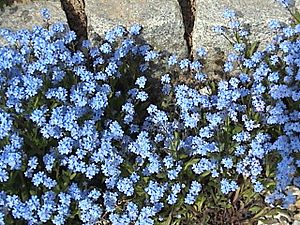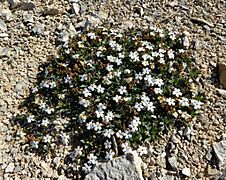Myosotis facts for kids
Quick facts for kids Myosotis |
|
|---|---|
 |
|
| Myosotis arvensis | |
| Scientific classification |
|
| Kingdom: | Plantae |
| Clade: | Tracheophytes |
| Clade: | Angiosperms |
| Clade: | Eudicots |
| Clade: | Asterids |
| Order: | Boraginales |
| Family: | Boraginaceae |
| Subfamily: | Boraginoideae |
| Genus: | Myosotis L. |
| Type species | |
| Myosotis scorpioides L.
|
|
Myosotis (/ˌmaɪəˈsoʊtɪs/ MY-ə-SOH-tiss) is a genus of flowering plants in the family Boraginaceae. The name comes from the Ancient Greek μυοσωτίς "mouse's ear", which the foliage is thought to resemble. In the Northern Hemisphere, they are colloquially known as forget-me-nots or scorpion grasses. Myosotis alpestris is the official flower of Alaska and Dalsland, Sweden. Plants of the genus are commonly confused with Chatham Islands' forget-me-nots, which belong to the related genus Myosotidium.
Description
The genus was originally described by Carl Linnaeus. The type species is Myosotis scorpioides. Myosotis species are annual or perennial, herbaceous, flowering plants with pentamerous actinomorphic flowers with five sepals and petals. Flowers are typically 1 cm in diameter or less, flatly faced, coloured blue, pink, white or yellow with yellow centres and borne on scorpioid cymes. Their foliage is alternate, and their roots are generally diffuse. They typically flower in spring or soon after the melting of snow in alpine ecosystems.
The seeds are contained in small, tulip-shaped pods along the stem to the flower. The pods attach to clothing when brushed against and eventually fall off, leaving the small seed within the pod to germinate elsewhere. Seeds can be collected by placing a sheet of paper under stems and shaking the seed pods onto the paper.
Myosotis scorpioides is colloquially called scorpion grass because of the spiraling curvature of its inflorescence.
Distribution
The genus is largely restricted to western Eurasia, with about 60 confirmed species, and New Zealand with around 40 endemic species. A few species occur elsewhere, including North America, South America, and Papua New Guinea. Despite this, Myosotis species are now common throughout temperate latitudes because of the introduction of cultivars and alien species. Many are popular in horticulture. They prefer moist habitats. In locales where they are not native, they frequently escape to wetlands and riverbanks. Only those native to the Northern Hemisphere are colloquially called "forget-me-nots".
One or two European species, especially Myosotis sylvatica, the "woodland" forget-me-not, have been introduced into most of the temperate regions of Europe, Asia, and the Americas.
Genetic analysis indicates that the genus originated in the Northern Hemisphere, and that species native to New Zealand, Australia, New Guinea, and South America form a lineage of closely related species that are likely derived from a single dispersal event to the Southern Hemisphere.
Ecology
Myosotis species are food for the larvae of some Lepidoptera species, including the setaceous Hebrew character. Many of the species in New Zealand are threatened.
Taxonomy
Of more than 510 recorded species names, only 152 species are presently accepted, listed below. The remainder are either synonyms or hybrids of presently accepted or proposed names.
- Myosotis abyssinica Boiss. & Reut.
- Myosotis afropalustris C.H. Wright
- Myosotis albicans Riedl
- Myosotis albiflora Banks & Sol. ex Hook.f.
- Myosotis albosericea Hook.f.
- Myosotis alpestris F.W.Schmidt (alpine forget-me-not)
- Myosotis amabilis Cheeseman
- Myosotis ambigens (Bég.) Grau
- Myosotis angustata Cheeseman
- Myosotis anomala Riedl
- Myosotis antarctica Hook.f.
- Myosotis arnoldii L.B.Moore
- Myosotis arvensis (L.) Hill (field forget-me-not)
- Myosotis asiatica (Vestergr. ex Hultén) Schischk. & Serg. (Asiatic forget-me-not)
- Myosotis atlantica Vestergr.
- Myosotis australis R.Br.
- Myosotis austrosibirica O.D.Nikif.
- Myosotis azorica H.C.Watson (Azores forget-me-not)
- Myosotis baicalensis O.D.Nikif.
- Myosotis balbisiana Jord.
- Myosotis bothriospermoides Kitag.
- Myosotis brachypoda Gren.
- Myosotis brevis de Lange & Barkla
- Myosotis brockiei L.B.Moore & M.J.A.Simpson
- Myosotis bryonoma Meudt, Prebble & Thorsen
- Myosotis butorinae Stepanov
- Myosotis cadmea Kitag
- Myosotis cameroonensis Cheek & R.Becker
- Myosotis capitata Hook.f.
- Myosotis chaffeyorum Lehnebach
- Myosotis chakassica O.D.Nikif.
- Myosotis cheesemanii Petrie
- Myosotis × cinerascens Petrie
- Myosotis colensoi (Kirk) J.F.Macbr.
- Myosotis concinna Cheeseman
- Myosotis congesta Shuttlew.
- Myosotis corsicana (Fiori) Grau
- Myosotis czekanowskii (Trautv.) Kamelin & V.N.Tikhom.
- Myosotis daralaghezica T.N.Popova
- Myosotis debilis Pomel
- Myosotis decumbens Host
- Myosotis diminuta Grau
- Myosotis discolor Pers. (changing forget-me-not)
- Myosotis densiflora C. Koch
- Myosotis dissitiflora Baker
- Myosotis ergakensis Stepanov
- Myosotis exarrhena F. Muell.
- Myosotis eximia Petrie
- Myosotis explanata Cheeseman
- Myosotis forsteri Lehm.
- Myosotis gallica Vestergr.
- Myosotis galpinii C.H.Wright
- Myosotis glabrescens L.B.Moore
- Myosotis glauca (G.Simpson & J.S.Thomson) de Lange & Barkla
- Myosotis goyenii Petrie
- Myosotis graminifolia DC.
- Myosotis graui Selvi
- Myosotis guneri A.P.Khokhr.
- Myosotis heteropoda Trautv.
- Myosotis hikuwai Meudt, Prebble & G.M.Rogers
- Myosotis imitata Serg.
- Myosotis incrassata Guss.
- Myosotis jenissejensis O.D.Nikif.
- Myosotis jordanovii N.Andreev & Peev
- Myosotis kamelinii O.D.Nikif.
- Myosotis kazakhstanica O.D.Nikif.
- Myosotis kebeshensis Stepanov
- Myosotis keniensis T.C.E.Fr.
- Myosotis koelzii Riedl
- Myosotis kolakovskyi A.P.Khokhr.
- Myosotis krasnoborovii O.D.Nikif. & Lomon.
- Myosotis krylovii Serg.
- Myosotis kurdica Riedl
- Myosotis laeta Cheeseman
- Myosotis laingii Cheeseman
- Myosotis latifolia Poir. (broadleaf forget-me-not)
- Myosotis laxa Lehm. (tufted forget-me-not or bay forget-me-not)
- Myosotis lazica Popov
- Myosotis lithospermifolia Hornem.
- Myosotis lithuanica (Schmalh.) Besser ex Dobrocz.
- Myosotis litoralis Steven ex M.Bieb.
- Myosotis ludomilae Zaver.
- Myosotis lyallii Hook.f.
- Myosotis macrantha (Hook.f.) Benth. & Hook.f.
- Myosotis macrosiphon Font Quer & Maire
- Myosotis macrosperma Engelm. (largeseed forget-me-not)
- Myosotis magniflora A.P.Khokhr.
- Myosotis margaritae Štěpánková
- Myosotis maritima Hochst. ex Seub.
- Myosotis martini Sennen
- Myosotis matthewsii L.B.Moore
- Myosotis michaelae Štěpánková
- Myosotis micrantha Pall. ex Lehm.
- Myosotis minutiflora Boiss. & Reut.
- Myosotis monroi Cheeseman (Monro's forget-me-not)
- Myosotis nemorosa Besser
- Myosotis nikiforovae Stepanov
- Myosotis ochotensis O.D.Nikif.
- Myosotis olympica Boiss.
- Myosotis oreophila Petrie
- Myosotis pansa (L.B.Moore) Meudt, Prebble, R.J.Stanley & Thorsen
- Myosotis paucipilosa (Grau) Ristow & Hand
- Myosotis persoonii Georges RouyRouy & E.G.Camus
- Myosotis petiolata Hook.f.
- Myosotis platyphylla Boiss.
- Myosotis popovii Dobrocz.
- Myosotis pottsiana (L.B.Moore) Meudt, Prebble, R.J.Stanley & Thorsen
- Myosotis propinqua (Turcz.) Fisch. & C.A.Mey.
- Myosotis pulvinaris Hook.f.
- Myosotis pusilla Loisel.
- Myosotis radix-palaris A.P.Khokhr.
- Myosotis ramosissima Rochel (early forget-me-not)
- Myosotis rakiura L.B.Moore
- Myosotis refracta Boiss.
- Myosotis rehsteineri (Hausm.) Wartm. ex Reut.
- Myosotis retrorsa Meudt, Prebble & Hindmarsh-Walls
- Myosotis rivularis (Vestergr.) A.P. Khokhr
- Myosotis robusta D.Don
- Myosotis sajanensis O.D.Nikif.
- Myosotis saxatilis Petrie
- Myosotis saxosa Hook.f.
- Myosotis schistosa A.P.Khokhr.
- Myosotis schmakovii O.D.Nikif.
- Myosotis scorpioides (L.)]] (true forget-me-not)
- Myosotis secunda Al.Murray (creeping forget-me-not)
- Myosotis semiamplexicaulis DC.
- Myosotis sicula Guss. (Jersey forget-me-not)
- Myosotis solange Greuter & Zaffran
- Myosotis soleirolii Godr.
- Myosotis sparsiflora J.C.Mikan ex Pohl
- Myosotis spatulata G.Forst.
- Myosotis speciosa Pomel
- Myosotis speluncicola Schott ex Boiss.
- Myosotis stenophylla Knaf
- Myosotis stolonifera(J.Gay ex DC.) J.Gay ex Leresche & Levier
- Myosotis stricta Link ex Roem. & Schult.
- Myosotis suavis Petrie]
- Myosotis subcordata Riedl
- Myosotis sylvatica Ehrh. ex Hoffm. (wood forget-me-not)
- Myosotis tenericaulis Petrie
- Myosotis taverae Valdés
- Myosotis tineoi C.Brullo & Brullo
- Myosotis traillii Kirk
- Myosotis traversii Hook.f.
- Myosotis tuxeniana (O.Bolòs & Vigo) O.Bolòs & Vigo
- Myosotis ucrainica Czern.
- Myosotis ultramafica Meudt, Prebble & Rance
- Myosotis umbrosa Meudt, Prebble & Thorsen
- Myosotis uniflora Hook.f.
- Myosotis urceolaris Shuttlew.
- Myosotis venosa Colenso
- Myosotis venticola Meudt & Prebble
- Myosotis verna Nutt. (spring forget-me-not)
- Myosotis vestergrenii Stroh
- Myosotis welwitschii Boiss. & Reut.
- Myosotis wumengensis L.Wei
Gallery
Symbolism
The small, blue forget-me-not flower was first used by the Grand Lodge Zur Sonne, in 1926, as a Masonic emblem at the annual convention in Bremen, Germany. In 1938, a forget-me-not badge—made by the same factory as the Masonic badge—was chosen for the annual Nazi Party Winterhilfswerk, the annual charity drive of the National Socialist People's Welfare, the welfare branch of the Nazi party. This coincidence enabled Freemasons to wear the forget-me-not badge as a secret sign of membership.
After World War II, the forget-me-not flower was used again as a Masonic emblem in 1948 at the first Annual Convention of the United Grand Lodges of Germany. The badge is now worn in the coat lapel by Freemasons around the world to remember all who suffered in the name of Freemasonry, especially those during the Nazi era.
The flower is also used as a symbol of remembrance by the people of Newfoundland and Labrador. It is used to commemorate those from the province who were killed in the First World War, and worn around July 1.
It is also used in Germany to commemorate the fallen soldiers of the world wars in a similar manner to the use of remembrance poppies in the UK.
The flower is also the symbol for the Armenian genocide's 100th anniversary. The design of the flower is a black dot symbolising the past, and the suffering of Armenian people. The light purple appendages symbolise the present, and unity of Armenians. The five purple petals symbolise the future, and the five continents to which Armenians escaped. The yellow in the centre symbolises eternity, and the Tsitsernakaberd itself symbolises the 12 provinces lost to Turkey.
In Lithuania, the flower has become one of the symbols for the commemoration of the January events of 1991.
In the Netherlands, the forget-me-not has become a symbol for Alzheimer Nederland, a foundation advocating for people suffering from dementia.
In New Zealand, the forget-me-not is the symbol for Alzheimers New Zealand, the foundation advocating for people suffering from Alzheimer's disease and dementia.
In history of art, the forget-me-not is used to remember loved ones who have died, so is very common in funerary portraits.
See also
 In Spanish: Nomeolvides (planta) para niños
In Spanish: Nomeolvides (planta) para niños










